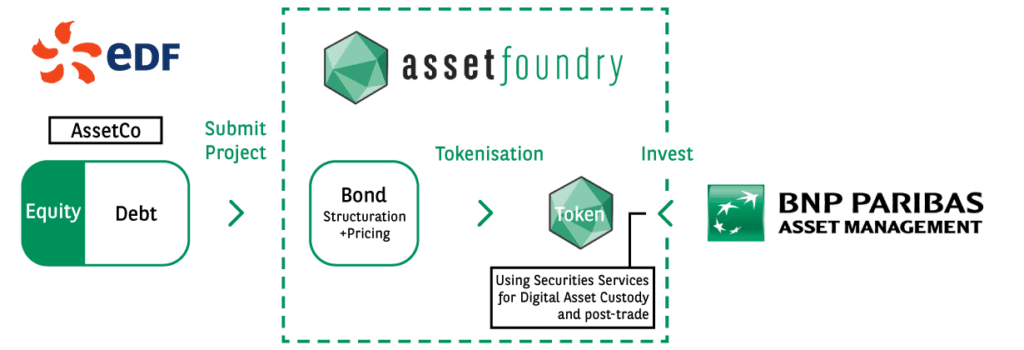EDF issues ESG tokenised bond with BNP Paribas Asset Foundry
Energy giant EDF has issued an ESG tokenised bond through BNP Paribas digital assets platform AssetFoundry.
Thanks to tokenisation, investors can access more transparent investment opportunities, and small projects can reach a much wider set of potential investors.

Global energy transition will require a significant increase in financing over the coming years. However, the financing is still quite inefficient, especially in private debt domain. Tokenisation could help open new sources of funding for projects which previously could not tap a wider investor pool.
As electricity demand worldwide rises, greenhouse gas emissions are currently surging. Global CO2 emissions related to energy grew to their highest level in 2021, reaching 36.3 gigatons, according to the International Energy Agency (IEA).
Reducing these emissions will involve a combination of sustainable investments together with the accelerated deployment of clean energy technologies.
What is critical to this transformation within the private sector is the integration of environmental, social and governance (ESG) standards in companies, and investment decisions. Tokenisation can play a key role in increasing ESG data transparency by tracking the origin of the data and verifying its authenticity and credibility. As a financial instrument, tokens can encapsulate value and data on the blockchain, and can be passed on, or traded, almost instantly in an efficient and traceable manner.

Tokenisation will transform ESG-linked financing. It provides transparency, scale, better granularity for smaller amounts, and verifiability of ESG data across the whole value chain.
Khoi-Ahn Berger-Luong, Head of BNP Paribas Real Assets
While investors are increasingly integrating ESG data in their investment decisions, sourcing reliable and comparable data remains a challenge, with the two main sources of information coming from company reports and from specialised third-party ESG ratings. Investors also need access to broader information from across a company’s ESG value chain and more granular data at a project level.
Small-scale renewable energy projects have not attracted much investor interest because the collection and authentication of performance data is challenging, and transaction costs related to structuring, due diligence and other elements of traditional funding are high in proportion to amounts invested. Hence, better access to lower-cost funding is critical for such small projects.
“Tokenisation will transform ESG-linked financing. It provides transparency, scale, better granularity for smaller amounts, and verifiability of ESG data across the whole value chain,” points out Khoi-Ahn Berger-Luong, Head of BNP Paribas Real Assets.
Therefore, with tokenisation, not only can investors access more transparent investment opportunities, but small projects can reach a much wider set of potential investors and create new ways of raising capital thanks to its digital format and low cost per trade. Tokenisation is the issuance of securities as native digital assets, which means that they can be recorded, moved and stored on the blockchain in a transparent way.
Julien Clausse, Head of AssetFoundry, BNP Paribas CIB’s Tokenisation & Digital Assets Platform, explains: “Tokenisation offers a unique opportunity to package both the financing means (the Bond) and the underlying assets data, more specifically ESG. AssetFoundry provides strong transparency to our clients and decision support for their investments by having an end-to-end originate-to-distribute approach”.
Chart: Benefits of tokenisation

New generations of blockchain have addressed energy consumption issues due to the particular structure of blockchain systems.
In the early days of blockchain, computers had to solve complex mathematical problems in order to verify transactions, thus consuming high levels of energy. Blockchain technology has come a long way since its inception and consumes a lot less energy today than its earlier versions.
For instance, the latest update of Ethereum, also known as Layer 1 blockchain or primary chain, which was released in September 2022, has cut 99.9%+ of energy consumption while making the network’s validation process more secure. Likewise, the total annual carbon footprint of the third-generation blockchain protocol Tezos is equivalent to the average annual energy footprint of 17 global citizens.

AssetFoundry provides strong transparency to our clients and decision support for their investments by having an end-to-end originate-to-distribute approach.
Julien Clausse, Head of AssetFoundry, BNP Paribas CIB’s Tokenisation & Digital Assets Platform
In July 2022, EDF ENR, a subsidiary of French power utility company EDF, and BNP Paribas issued an ESG tokenised bond through AssetFoundry, BNP Paribas’ digital assets platform. The tokenisation of a solar energy project bond demonstrated how security tokens can improve funding of small-scale photovoltaic solar panel projects.
Chart: Transaction overview

The project tested the following two specific use cases to validate the approach:
BNP Paribas CIB structured and tokenised the security as a native digital asset, which was issued, registered and transferred on the public Ethereum blockchain according to the French law for unlisted securities.
BNP Paribas Asset Management purchased the security token using traditional fiat while BNP Paribas Securities Services managed the custody aspects of the token, that is, safeguarding of private keys required to access and transfer the tokens. This service is part of their ongoing effort to support their clients by developing digital asset services covering both new type of regulated digital assets along with traditional assets.
The bond’s international securities identification number (ISIN), term sheet and ESG data were embedded in the security token. This represented a significant improvement in verifying investors’ ESG impact and implied greater transparency and verifiability of the data across the whole value chain.
BNP Paribas’ AssetFoundry platform covered all aspects of tokenisation, issuance, legal, compliance and business processes. The platform is integrated into the Bank’s business systems and processes in order to offer scalable and seamless digital asset solutions to its clients.
From a legal and technical standpoint, this bond tokenisation project was the opportunity to develop new due diligence processes in order to reduce the time spent and the cost associated with small-scale projects, as well as to perform detailed analysis of all the risks involved.
Blockchain technologies and regulations are evolving at a fast-pace. Thus, it is important to manage continuity plans properly – especially for long-term bonds. The issued bond was fully processed by the Bank, and could have stayed as a token until its maturity. However, as part of AssetFoundry’s continuity plan, the tokenised bond was switched back to a traditional bond, without impacting the bond structure – e.g. the bond retained the same ISIN. This showcased BNP Paribas’ capability to switch the bond back to its traditional format if needed, hence proving that the bond value is secured over its entire life span.
While we are still at the beginning of the journey towards tokenisation of assets, this first ESG finance project has confirmed the key business benefits of tokenisation. In addition, it has opened up opportunities for other asset classes to be tokenised according to the legislation for the ‘EU pilot regime’ for market infrastructure based on blockchain technology, which comes into force on 23 March 2023.
Energy giant EDF has issued an ESG tokenised bond through BNP Paribas digital assets platform AssetFoundry.